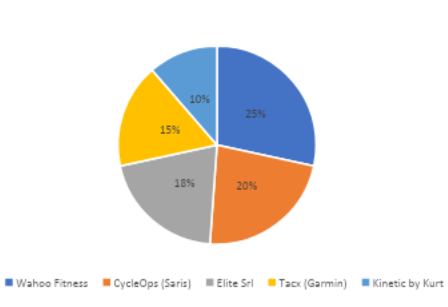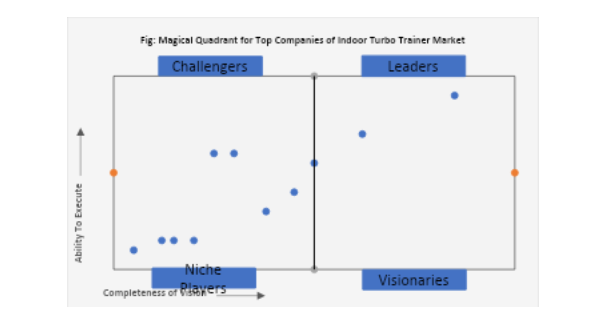Introduction to the Indoor Turbo Trainer Market
The Indoor Turbo Trainer market is witnessing steady growth, driven by the increasing adoption of indoor cycling as a convenient and efficient fitness solution. According to Cognitive Market Research, the market is valued at USD 514.8 million in 2024 and is projected to reach USD 820.5 million by 2032, expanding at a CAGR of 6.00%. Turbo trainers have gained popularity among professional cyclists, fitness enthusiasts, and home workout users due to their ability to simulate outdoor riding conditions, offering resistance control and real-time performance tracking. The market is further propelled by advancements in smart trainers, interactive training platforms, and increased awareness of health and fitness. The rising demand for connected fitness solutions and virtual training experiences is a key driver of market expansion. The integration of indoor turbo trainers with mobile apps, virtual cycling platforms like Zwift and TrainerRoad, and smart resistance technology is transforming the workout experience for users. Additionally, the growing trend of home-based fitness, accelerated by factors such as time constraints, adverse weather conditions, and convenience, is boosting product adoption. Manufacturers are focusing on innovation, incorporating AI-driven coaching, real-time performance analytics, and enhanced road-feel technology to cater to both professional athletes and casual riders. The shift towards silent, direct-drive trainers with electromagnetic resistance is further improving user experience, attracting more customers to the market.
Criteria for Comparing Companies in the Indoor Turbo Trainer Market
Cognitive Market Research assesses companies in the Indoor Turbo Trainer market based on several key factors, highlighting their competitive positioning, technological advancements, and market influence. Revenue and market share serve as primary indicators of a company’s ability to scale operations and meet the growing demand for high-performance fitness equipment. Brands with strong financial performance can invest in R&D, product differentiation, and customer engagement strategies, ensuring sustained growth. Innovation and technological integration are critical differentiators in this market. Companies leading the sector focus on developing smart turbo trainers with features such as automatic resistance adjustment, real-time feedback, and seamless connectivity with third-party cycling apps. The introduction of AI-powered training algorithms, precision power measurement, and immersive virtual riding experiences has elevated the market standard. Additionally, the demand for quieter, more stable trainers with enhanced durability is shaping product design trends, encouraging manufacturers to invest in advanced materials and engineering solutions.
Geographical presence plays a crucial role in a company’s ability to capture market share. The North American and European markets dominate due to a strong cycling culture, high fitness awareness, and widespread adoption of smart fitness equipment. Meanwhile, the Asia-Pacific region is emerging as a high-growth area, fueled by increasing disposable income, urbanization, and a growing interest in fitness and endurance sports. Companies with a global presence and robust distribution networks gain a competitive edge in reaching diverse consumer bases. Strategic partnerships and brand collaborations significantly impact market positioning. Manufacturers that partner with professional cycling teams, fitness influencers, and virtual training platforms enhance brand credibility and user engagement. Additionally, alliances with e-commerce platforms and fitness retailers help expand product accessibility and drive sales. Leading players such as Wahoo Fitness, Tacx (Garmin), Elite, and Saris are at the forefront of innovation, offering premium indoor turbo trainers tailored to various user segments. As the market continues to evolve, companies that focus on smart technology integration, user experience enhancement, and sustainable product development will shape the future of the Indoor Turbo Trainer market.
Top Companies Operating in the Indoor Turbo Trainer Industry Worldwide
- Wahoo Fitness
- CycleOps (Saris)
- Elite Srl
- Tacx (Garmin)
- Kinetic by Kurt
- Bkool
- Minoura
- Bianchi
- Rocker Blocks
- LifeLine
Top Manufacturing Companies of Indoor Turbo Trainer:
Wahoo Fitness, CycleOps (Saris), Elite Srl, Tacx (Garmin), and Kinetic by Kurt are the key players in the Indoor Turbo Trainer Market
Wahoo Fitness
Wahoo Fitness leads the Indoor Turbo Trainer Market with a 25% market share, setting the benchmark for high-performance, technology-driven indoor cycling trainers. The company is renowned for its advanced smart trainers, including the KICKR series, which offer realistic road-feel simulation, interactive resistance control, and seamless integration with virtual cycling platforms such as Zwift, TrainerRoad, and Rouvy.
CycleOps (Saris)
CycleOps, a brand under Saris, commands a 20% market share, widely recognized for its durable and performance-focused turbo trainers. The company has built a strong reputation for offering high-quality direct-drive and wheel-on trainers, such as the H3 Smart Trainer, which features whisper-quiet operation, accurate power measurement, and seamless connectivity with cycling apps.
Elite Srl holds an 18% market share, positioning itself as a leading European manufacturer of high-tech indoor cycling trainers. The company is best known for its direct-drive and fluid trainers, including models like the Direto XR-T and Suito-T, which offer realistic pedaling dynamics, high resistance levels, and smart connectivity. In 2023, Elite Srl generated over USD 180 million from indoor trainer sales, driven by the increasing adoption of interactive and immersive training solutions among cycling enthusiasts.
Tacx, a subsidiary of Garmin, holds a 15% market share, known for its premium smart trainers that integrate seamlessly with Garmin's cycling ecosystem. The company’s flagship products, such as the Tacx NEO 2T and Flux 2, are recognized for their exceptional road-feel simulation, virtually silent operation, and precise power measurement. In 2023, Tacx’s revenue from indoor trainers exceeded USD 150 million, driven by strong demand for advanced, high-performance training solutions among professional cyclists and serious enthusiasts.
Kinetic by Kurt secures a 10% market share, catering primarily to budget-conscious and mid-range indoor training enthusiasts. The company is well known for its fluid and smart-controlled trainers, such as the Kinetic Rock and Roll Smart 2, which features side-to-side motion, interactive resistance control, and wireless connectivity with major training apps.


Potential Threats to Top Five Players in the Indoor Turbo Trainer Market
CMR found that the indoor turbo trainer market is becoming increasingly competitive, with emerging players challenging the dominance of well-established brands. Leading companies such as Wahoo Fitness, Tacx (Garmin), Elite, Saris, and Kinetic have historically maintained strong market positions due to their advanced technology, brand reputation, and wide distribution networks. However, new entrants such as Bkool, Minoura, Bianchi, Rocker Blocks, and LifeLine are gradually capturing market share by offering cost-effective, technologically advanced, and highly customizable indoor training solutions. As the demand for indoor cycling trainers surges driven by a growing fitness-conscious population and the rise of virtual cycling platforms the threat to the top players has intensified.
One of the biggest threats to market leaders is the rapid innovation in smart trainers and immersive indoor cycling experiences. Emerging brands are introducing trainers equipped with cutting-edge simulation technologies, wireless connectivity, and enhanced resistance control at competitive price points. Additionally, the integration of augmented reality (AR) and artificial intelligence (AI)-driven analytics in indoor cycling apps is making it easier for new players to differentiate their offerings. Companies like Bkool, for instance, have gained traction by offering an advanced training platform that provides virtual routes and customizable training plans. Furthermore, the rising popularity of direct-drive trainers, which provide a more realistic road feel and quieter operation, is pushing established brands to rethink their product strategies. The shift in consumer preference toward more affordable and innovative options presents a substantial challenge to dominant market players.
Conclusion
Investments in Smart Technologies, Realistic Ride Feel, and Consumer Engagement Are Essential for Long-Term Success in the Indoor Turbo Trainer Market
The indoor turbo trainer market is evolving rapidly, driven by advancements in smart training technology, increasing demand for immersive cycling experiences, and shifting consumer preferences toward more affordable options. To remain competitive, both established and emerging players must continuously innovate and adapt to these changing trends. Investing in AI-powered training analytics, enhanced resistance control, and seamless virtual cycling integration will be critical for maintaining a strong market presence. Additionally, as indoor cycling communities continue to expand, brands that prioritize user engagement, personalized experiences, and interactive content will have an edge over competitors. Creating cycling challenges, virtual racing leagues, and data-driven performance insights can enhance brand loyalty and encourage repeat purchases. Companies that strategically invest in smart connectivity, realistic ride simulation, and flexible pricing models will be best positioned to capture a significant share of this growing market. In an industry where technological innovation and consumer experience drive purchasing decisions, long-term success will depend on the ability to offer high-performance, interactive, and engaging training solutions that cater to the evolving needs of modern cyclists.
Author's Detail:
Sonali Shinde /
LinkedIn
Sonali Shinde is a dynamic Research Analyst with a proven track record in the banking and finance sector. With over three years of experience, she brings a deep understanding of financial markets, regulatory environments, and competitive landscapes. Sonali is skilled in conducting market intelligence, trend analysis, and risk assessment, delivering insights that empower strategic decision-making.
Currently, Sonali plays a pivotal role in driving research initiatives within the banking and finance industry. Her expertise in crafting comprehensive research frameworks and her ability to distill complex financial data into actionable recommendations have been instrumental in shaping her organization’s strategies.
Known for her meticulous approach and forward-thinking mindset, Sonali is passionate about driving innovation and fostering growth in the banking and finance sector. Her dedication to excellence and her commitment to staying ahead of industry trends make her an invaluable asset to her team and the broader financial community.
